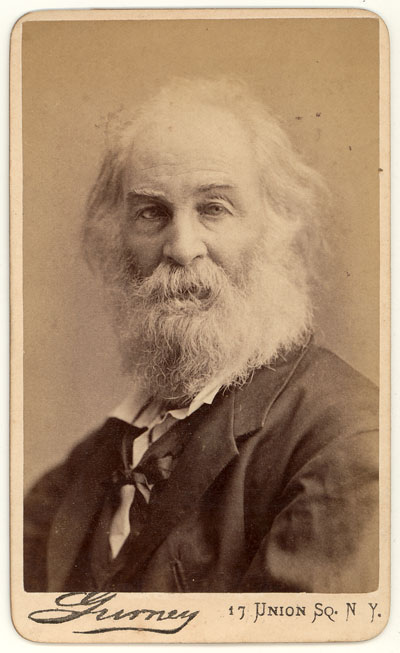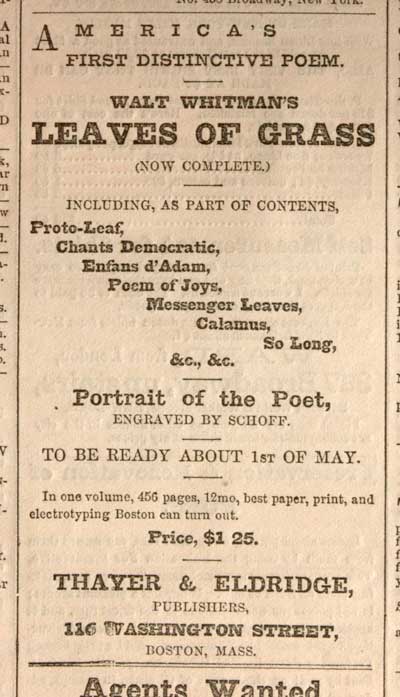Difference between revisions of "Wilson Collection: The Calamus Poems"
(Walt Whitman) |
(Calamus poems) |
||
| (5 intermediate revisions by the same user not shown) | |||
| Line 1: | Line 1: | ||
| − | |||
[[File:Whitman.jpg]] | [[File:Whitman.jpg]] | ||
[[File:WhitmanNewspaper.jpg]] | [[File:WhitmanNewspaper.jpg]] | ||
| − | (Carte de visite photograph of Walt Whitman, 1871, | + | ''(Carte de visite photograph of Walt Whitman, 1871, and advertisement from Harper's Weekly newspaper, May 5, 1860, for the 1860 edition of Leaves of Grass debuting the Calamus poems)'' |
| − | and advertisement from Harper's Weekly newspaper, May 5, 1860, | ||
| − | for the 1860 edition of Leaves of Grass debuting the Calamus poems) | ||
| − | The Calamus Poems | + | '''The Calamus Poems''' |
The “Calamus cluster” of poems first appeared in the 1860 edition of Leaves of Grass. They and their author, Walt Whitman, were pivotal to early homosexual emancipation efforts. | The “Calamus cluster” of poems first appeared in the 1860 edition of Leaves of Grass. They and their author, Walt Whitman, were pivotal to early homosexual emancipation efforts. | ||
| − | In verse, the Poet connected the calamus plant to intimacy between males: “(O here [at pond-side] I last saw him that tenderly loves me... / And this, O this shall henceforth be the token of comrades, this calamus root...)” | + | In verse, the Poet connected the calamus plant to intimacy between males: “(O here [at pond-side] I last saw him that tenderly loves me... / And this, O this shall henceforth be the token of comrades, this calamus root...)”<ref>Walt Whitman, ''Leaves of Grass'', intro. Justin Kaplan (New York: Bantam Classic, 1983), 100.</ref> |
| − | The Calamus poems include such verse as “In the stillness in the autumn moonbeams his face was inclined / toward me, / And his arm lay lightly around my breast—and that night I was / happy.” | + | The Calamus poems include such verse as “In the stillness in the autumn moonbeams his face was inclined / toward me, / And his arm lay lightly around my breast—and that night I was / happy.”<ref>Whitman, 103.</ref> In the poems Whitman speaks of establishing “[t]he institution of the dear love of comrades.”<ref>Whitman, 108.</ref> |
| − | References | + | ==''References''== |
| − | + | <references /> | |
| − | + | ||
| − | + | ||
| + | |||
| + | ==''To return to "Exhibit contents" links, click:''== | ||
| + | ==[[Rich Wilson: Aspects of Queer Existence in 19th-Century America]]== | ||
| + | |||
| + | ==''See also:''== | ||
| + | |||
| + | ==[[Whitman, Symonds, Carpenter: "In paths untrodden," 1859-1924]]== | ||
Latest revision as of 14:02, 19 November 2012
(Carte de visite photograph of Walt Whitman, 1871, and advertisement from Harper's Weekly newspaper, May 5, 1860, for the 1860 edition of Leaves of Grass debuting the Calamus poems)
The Calamus Poems
The “Calamus cluster” of poems first appeared in the 1860 edition of Leaves of Grass. They and their author, Walt Whitman, were pivotal to early homosexual emancipation efforts.
In verse, the Poet connected the calamus plant to intimacy between males: “(O here [at pond-side] I last saw him that tenderly loves me... / And this, O this shall henceforth be the token of comrades, this calamus root...)”[1]
The Calamus poems include such verse as “In the stillness in the autumn moonbeams his face was inclined / toward me, / And his arm lay lightly around my breast—and that night I was / happy.”[2] In the poems Whitman speaks of establishing “[t]he institution of the dear love of comrades.”[3]
References

